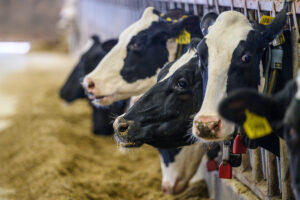Late last week, Wisconsin Sea Grant sponsored a panel (watch a recording) about the effect of phosphorus flowing off surrounding land and into waterways. An excess of the nutrient can lead to the growth of a bacteria known as cyanobacteria, also called blue-green algae.
Blue-green algae blooms are potentially fatal to pets, fish and other wildlife. They can also consume all the oxygen in a waterbody, destroying the biodiversity of an ecosystem that may have formerly teemed with plants, fish, frogs and mussels.
For people, there is some concern that just being near affected water could cause neurological conditions, such as ALS, said one of the panelists, Dan Egan. “You don’t want toxic blue-green algae in your life, in your neighborhood. You don’t want it anywhere.”
More than 1,500 people attended the event held at the University of Wisconsin—Madison Memorial Union Terrace on the shore of Lake Mendota, which Egan has called “ground zero” due to frequent and toxic blue-green algal blooms and its status as a what’s been termed the most studied lake in the world because the Center for Limnology is located along it. UW—Madison is where the field of American limnology began in the 1800s.
Last spring, Egan published “The Devil’s Element: Phosphorus and a World Out of Balance,” which outlines the world’s mining, processing and use of phosphorus. It also explains the element’s paradox—phosphorus brings agricultural plenty but can lead to devastation in waterways.

A panel hosted by entertainer Charlie Berens brought together experts and a journalist to discuss water qualty.
Jake Vander Zanden, an expert on freshwater lakes and director of the Center for Limnology, and Randy Jackson, a professor from the university’s Department of Agronomy who spoke about agriculture’s role in nutrient loading, rounded out the panel.
The conversation among the trio was moderated by popular entertainer Charlie Berens, known for his humorous takes on Wisconsin norms, speech and food choices as host of the Manitowoc Minute newscast and through his bestselling book, “The Midwest Survival Guide.”
For this event, though, Berens used his notoriety and established platform—his Cripescast podcast, which explores Midwestern themes and people and where the recorded panel discussion from late August is archived here—to call attention to this important environmental topic.
Egan noted that phosphorus is in every single cell on Earth. It doesn’t go away and since time immemorial has been part of a cycle that allowed a trickle of phosphorus into the world. However, he noted, “We’ve turned that cycle into a straight line and that line runs into the water” when phosphorus in the form of fertilizer is applied to farm fields, golf courses and lawns.
“Phosphorus puts food on our table. It’s existed forever, but in the last 120 years we’ve figured out how to turn a slow trickle of this essential nutrient into a gusher.” Egan continued, “We are also burning through it at such a pace that it’s getting into the water, and when it gets into the water, it’s not gonna grow a kernel of corn or a soybean, it’s gonna grow algae. And too often it’s toxic algae.”
Vander Zanden highlighted other contributors, such as urban runoff. He used the Madison, Wisconsin, location as his demonstration case: Lake Mendota receives all the stormwater runoff from streets. “It’s important for you all to know that that water that runs off is not treated. It goes directly to the lake. It’s phosphorus that comes off, also oils and metals and all sorts of other pollutants.
“Another is sewage treatment effluents. That’s not a huge source in the grand scheme of things. And then there are other sources as well, industrial sources, factories and so on; those are actually minor. So, the Clean Water Act from 1972 addressed these sources quite nicely. The amount of phosphorus coming from those types has gone down a lot, and now what we are left with is agricultural and urban runoff from the landscape,” he said.
Agriculturally targeted solutions discussed included:
- Subsidizing not cropland but grassland that holds on to phosphorus and carbon and promoting biodiversity. This involves planting cover crops such as switchgrass and following no-till practices.
- Adopting agricultural practices such as avoiding manure spreading if the ground is frozen or if rain is predicted.
- Using alum treatments. Alum is a chemical that binds phosphorus. There are examples from around the world where alum was added to polluted waters. Vander Zanden said, “It sort of sucks up the phosphorus and sort of holds it. That’s a technical solution that may or may not be financially viable here.”

Photo by Althea Dotzour/ UW–Madison
The speakers also said the collective use of these solutions, holistically, could be a good approach to make progress.
Keying off that holistic approach, Jackson stressed the actors in the phosphorus-use cycle are “not nefarious. They are just reacting to the system we have set up.”
He offered a rallying cry, “The system only changes when we come together as a community and embrace the idea of collective action. This is how a lot of big things have happened in the world. Civil rights is an example of this. People come together in communities and engage in collective action so that the powers actually have to listen.”
Egan put a Badger State spin on it, “We have a license plate that shows a barn and water. Both are things that define this great state and should not be working at cross purposes. Often, they are. I think everybody values what’s on the right side, the barn. Everybody eats…but everybody also needs water, and you know, there’s no reason why we can’t have both.”





